This article was medically reviewed by Troy A. Miles, MD. Dr. Miles is an Orthopedic Surgeon specializing in Adult Joint Reconstruction in California. He received his MD from the Albert Einstein College of Medicine in 2010, followed by a residency at the Oregon Health & Science University and fellowship at the University of California, Davis. He is a Diplomat of the American Board of Orthopaedic Surgery and is a member of the American Association of Hip and Knee Surgeons, American Orthopaedic Association, American Association of Orthopaedic Surgery, and the North Pacific Orthopaedic Society.
There are 15 references cited in this article, which can be found at the bottom of the page.
wikiHow marks an article as reader-approved once it receives enough positive feedback. In this case, 86% of readers who voted found the article helpful, earning it our reader-approved status.
This article has been viewed 126,300 times.
Experts say ankle swelling usually goes away on its own, but it's best to check with your doctor if you're injured or have unexplained swelling.[1] A swollen ankle can be painful and inconvenient, so you likely want to feel better fast. Research suggests that you may be able to care for your swollen ankle at home by resting, icing your ankle, elevating your ankle, and applying a compression wrap.[2] If your ankle doesn't start to feel better after a few days, consult your healthcare provider to find out if you need medical treatment.
Steps
Promoting a Fast Recovery
-
1Schedule an appointment with your doctor or visit an emergency room. If you have been injured and you are in pain, seek medical treatment right away. Visit an emergency room if you think you need immediate treatment or if you cannot get in to see your regular doctor. When your doctor examines you, she will ask you questions and check for certain signs to determine the degree and type of injury that you have. Be honest about your pain and other symptoms to help your doctor diagnose and treat your injury. The grades of common, low ankle injury include:
- Grade I is a partial tear of the ligament with no functional loss or impairment. The person can still walk and bear weight on the affected side. You may have some mild pain and mild bruising.[3]
- Grade II is an incomplete tear of the ligament or ligaments with moderate functional impairment, meaning it is difficult to bear weight on the affected foot and you may need crutches. You will have some moderate pain, bruising, and swelling. Your doctor may also notice some limitations in your range of motion.[4]
- Grade III is a complete tear and loss of the structural integrity of the ligaments. The patient will be unable to bear any weight or walk unassisted. You will have severe bruising and severe swelling.[5]
-
2Be aware of high ankle sprains. Common ankle sprains involve the ATFL ligament, which stabilizes the ankle and is commonly injured by "rolling" the ankle.[6] These injuries are "low ankle" sprains, but you may also experience a "high ankle" sprain, especially if you are an athlete. This affects a different ligament, the syndesmosis, which is located above the ankle joint. You will experience less bruising and swelling with this kind of injury, but likely more pain and a longer recover time.[7]Advertisement
-
3Follow your doctor’s instructions. After you have had your swollen ankle evaluated, you will need to stick to your doctor’s treatment plan to cure your ankle. Your doctor will most likely recommend a period of resting, icing, compressing, and elevating your ankle. Call your doctor if your symptoms worsen or if they do not improve over time.
- Ask about physical therapy if you have a severe injury. Physical therapy may help to speed up your healing time and exercise reduces the chances that you will sprain your ankle again.[8]
-
4Rest your ankle for two or three days after the injury happens. Making sure your ankle gets plenty of rest for two or three days will help to speed up your recovery time. This means avoiding sports or other physical activities that involve putting pressure on your ankle. You may need to take some time off from work if you have a job where you need to stay on your feet for most of the day.[9] [10]
-
5Ice your ankle. Apply ice to your ankle for 15–20 minutes at a time to help reduce swelling and decrease pain. When you put ice on your ankle, it reduces the blood flow to the area so the swelling will go down faster. Icing your ankle can also help you to cope with the pain. Wrap the ice pack with a towel before pressing it against your skin.[11]
- After icing your ankle, wait about an hour before icing your ankle again. Too much exposure to the ice could cause skin damage.
-
6Compress your ankle. By compressing your ankle, you will restrict the movement of your ankle. Compression decreases swelling and speeds healing time as well. Wrap an ace bandage or compression device around the injured area.[12] [13]
- Take the compression off at night. Overnight compression may cause total restriction of blood flow in the foot and cause tissue death.
- Kinesio taping is another form of compression that has been shown to clinically reduce swelling. Ask your doctor or a physical therapist if he is trained in this technique.
-
7Elevate your ankle. Elevation limits the flow of blood to the affected area, which may help to reduce the swelling. You can elevate your ankle when you are sitting or when you are lying down. Use a couple of pillows or blankets to prop up your ankle so you’re your ankle is raised above the level of your heart.[14]
-
8Support your ankle while it recovers. Keeping pressure off your ankle by avoiding standing on it will help you to recover faster. You can use crutches or a cane to support yourself when you need to walk. Keep in mind that you need to support your ankle when going up and down stairs[15] .
- When going up steps, take the first step with your uninjured foot. The healthy leg shoulders all the load of the body while battling against gravity in this way.
- When going down steps, take the first step with your injured foot. This allows gravity to assist the injured leg while stepping down.
-
9Prepare for a recovery period of about 10 days. Following your doctor’s instructions and staying off of your injured ankle will help you to recover, but it often takes about 10 days for people to recover from ankle injuries.[16] Do not try to rush your recovery or you may make your injury worse. Take time off from work if necessary and ask for help from friends and family while you recover.
Using Medicine to Reduce Swelling
-
1Take NSAIDs with your doctor’s approval. Talk to your doctor about taking NSAIDs to help you deal with pain as you recover. Non-steroidal anti-inflammatory drugs (NSAIDs) work to reduce swelling and relieve the pain caused by your ankle injury. Common over-the-counter NSAIDs include ibuprofen (Advil or Motrin) or naproxen (Naprosyn).[17]
- Talk to your doctor before using NSAIDs if you have heart problems, a history of stomach ulcers, high blood pressure, kidney damage, or diabetes.
-
2Ask your doctor about celecoxib. Celecoxib (Celebrex®) works well to reduce inflammation caused by an ankle injury. This is because it controls the production of prostaglandins, which cause inflammation. You will need a prescription from your doctor for this medication. You should take celecoxib after a meal, because taking it on an empty stomach could lead to a stomachache.[18]
-
3Discuss piroxicam with your doctor. Piroxicam works by stopping prostaglandin formation. It has a sublingual form that melts under the tongue and goes directly to the blood so that it reduces swelling quickly.[19]
-
4Talk to your doctor about surgery as a last resort. Surgical therapy is rarely done for ankle sprains. It is only done in severe ankle sprains that do not respond to months of rehabilitation and medical therapy. If your ankle sprain is severe and has not improved after a long period of rehabilitation, ask your doctor if this may be a good option for you.
Reducing Activities That May Increase Swelling
-
1Stick to cold compresses. Avoid heat while your ankle recovers. Heat increases blood flow to the injured area and aggravates inflammation. Warm compresses, saunas, and steam showers may do more harm than good in the first three days after your injury occurs. Stay away from heat during this time and stick to cold compresses to help relieve pain and swelling.[20]
-
2Abstain from alcohol. Do not drink any alcohol while you are recovering. Alcoholic drinks open up the blood vessels in the body. When your blood vessels open up, the swelling in your ankle can become much worse. Alcohol will also delay the healing process, so it is a good idea to avoid it while you recover.
-
3Keep your movement low impact. Stay away from running and other physical activities to make sure that your ankle heals. Running and other high impact physical activities will only make things worse. Rest for at least one week before resuming exercise.
-
4Wait to massage your ankle. Do not massage your ankle for at least a week. While massaging the pain away in your ankle might sound like a good idea, giving your ankle a massage will just add external pressure to your injury. This external pressure will actually make the swelling worse.
- You can start to gently massage your ankle one week after you have allowed your ankle to rest and recover.
Warnings
- If you think your ankle may be broken, or if you have suffered a severe sprain, go to the hospital right away.⧼thumbs_response⧽
References
- ↑ https://www.nhs.uk/conditions/oedema/
- ↑ https://www.mayoclinic.org/diseases-conditions/sprained-ankle/diagnosis-treatment/drc-20353231
- ↑ http://www.aafp.org/afp/2001/0101/p93.html
- ↑ http://www.aafp.org/afp/2001/0101/p93.html
- ↑ http://www.aafp.org/afp/2001/0101/p93.html
- ↑ https://www.hss.edu/conditions_high-ankle-sprain-whats-different.asp
- ↑ https://www.hss.edu/conditions_high-ankle-sprain-whats-different.asp
- ↑ http://www.ncbi.nlm.nih.gov/pmc/articles/PMC3103112/
- ↑ http://www.aafp.org/afp/2006/1115/p1714.html
- ↑ https://www.sports-health.com/treatment/price-protocol-principles
- ↑ http://www.thelancet.com/journals/lancet/article/PIIS0140-6736(09)60206-3/abstract
- ↑ http://www.physioroom.com/injuries/ankle_and_foot/ankle_sprain_exer.php
- ↑ http://www.thelancet.com/journals/lancet/article/PIIS0140-6736(09)60206-3/abstract
- ↑ http://www.aafp.org/afp/2006/1115/p1714.html
- ↑ https://www.nlm.nih.gov/medlineplus/ency/patientinstructions/000343.htm
- ↑ http://www.ncbi.nlm.nih.gov/pmc/articles/PMC3103112/
- ↑ https://www.nhs.uk/conditions/nsaids/
- ↑ http://www.ncbi.nlm.nih.gov/pubmed/12216965
- ↑ https://journals.sagepub.com/doi/abs/10.1177/036354659702500419
- ↑ http://www.patient.info/health/Sprained-Ankle.htm
About This Article
To ease symptoms and speed up recovery time when you have a swollen ankle, start by staying off your ankle completely for 2-3 days. During this time, apply an ice pack to your ankle every hour for 15-20 minutes at a time and take ibuprofen to help reduce swelling and decrease pain. Also, wrap an ace bandage around the ankle and keep it elevated as much as possible. After a few days of rest, you can use crutches to help you get around until your ankle heals completely. For tips on massaging a swollen ankle, read on!
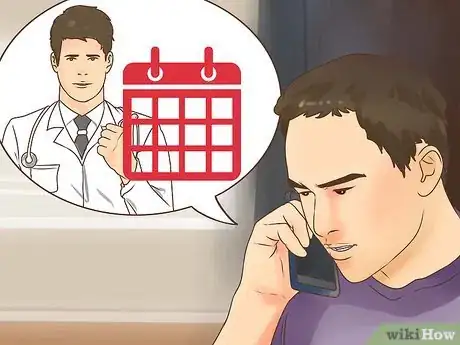
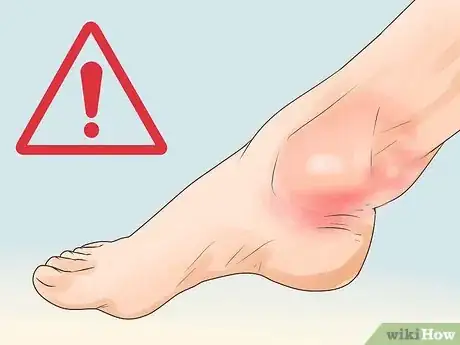
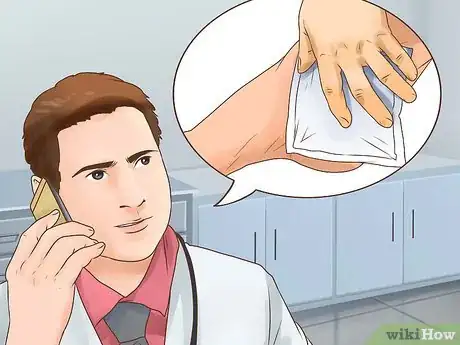
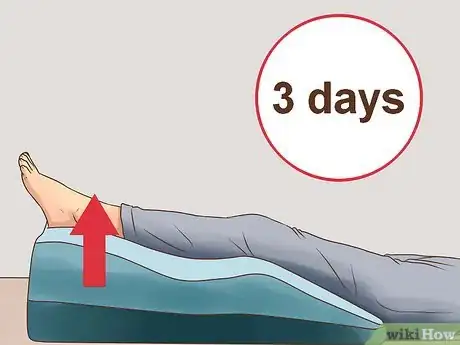
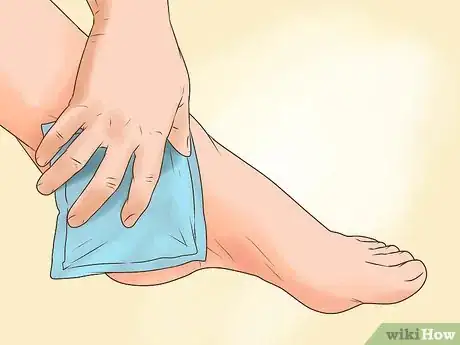
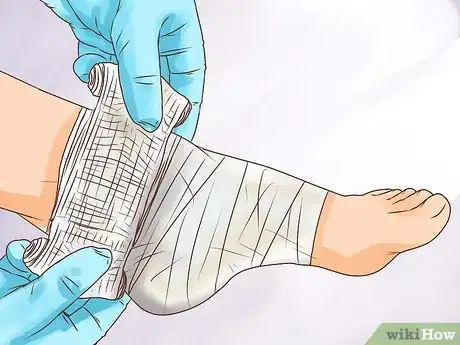
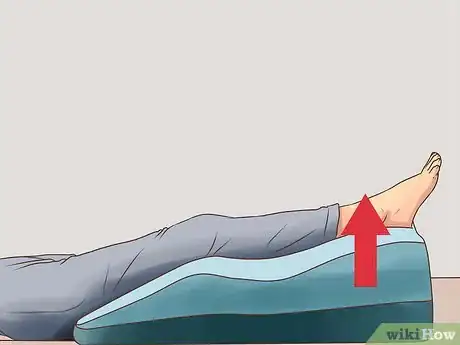
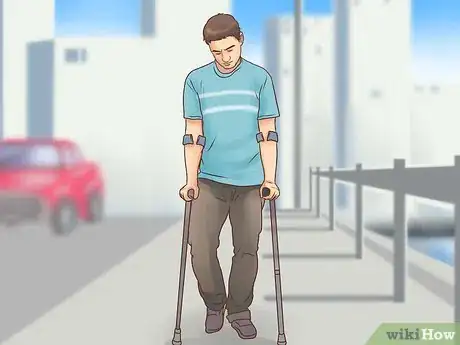
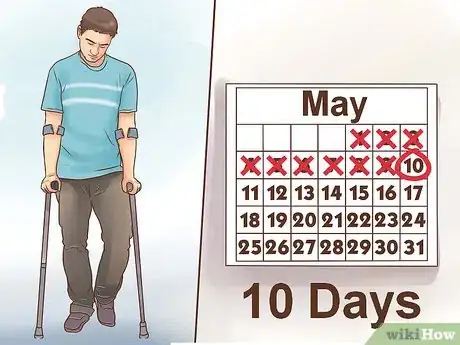
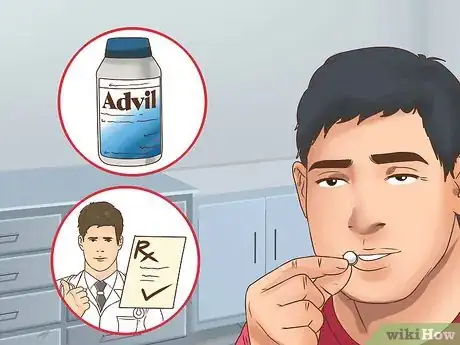
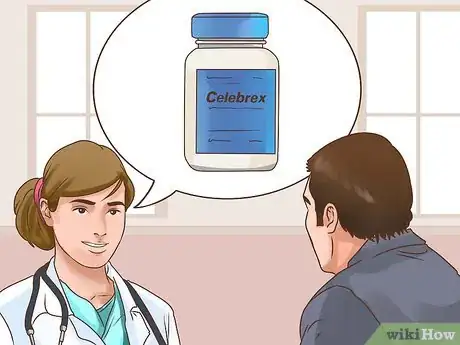
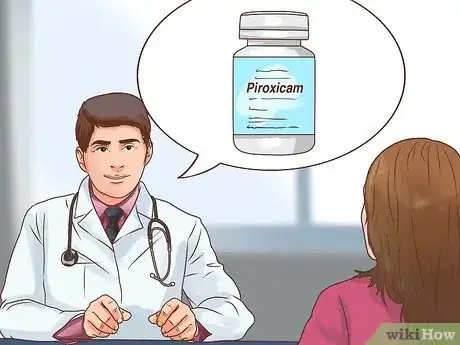
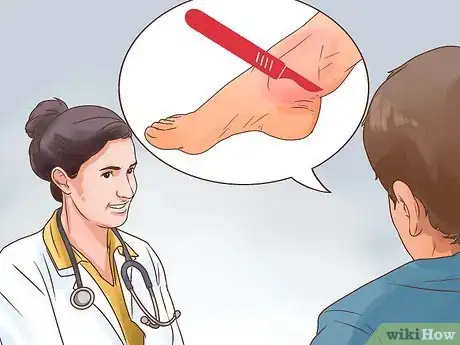
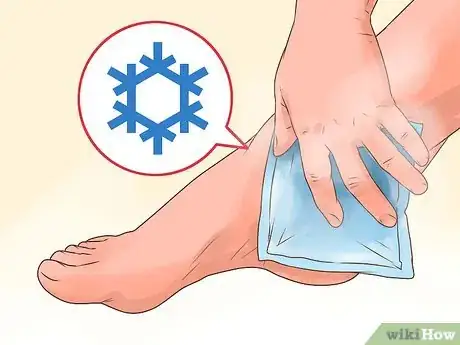
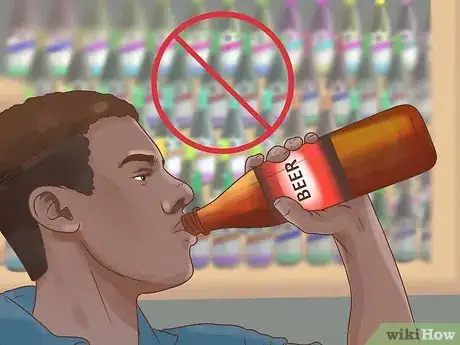
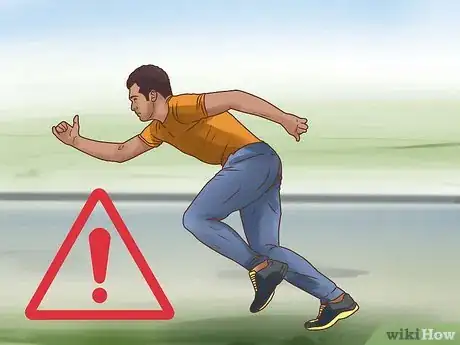
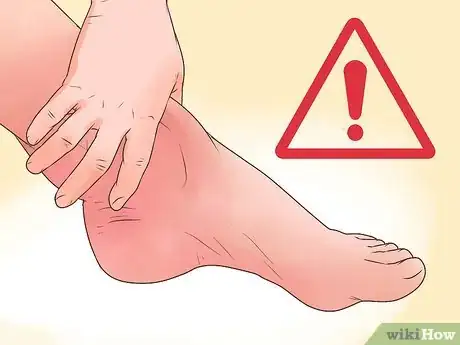



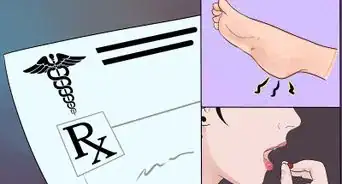


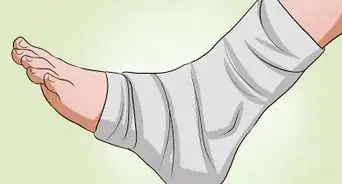










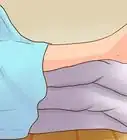

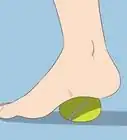
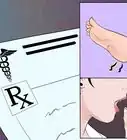



































Medical Disclaimer
The content of this article is not intended to be a substitute for professional medical advice, examination, diagnosis, or treatment. You should always contact your doctor or other qualified healthcare professional before starting, changing, or stopping any kind of health treatment.
Read More...